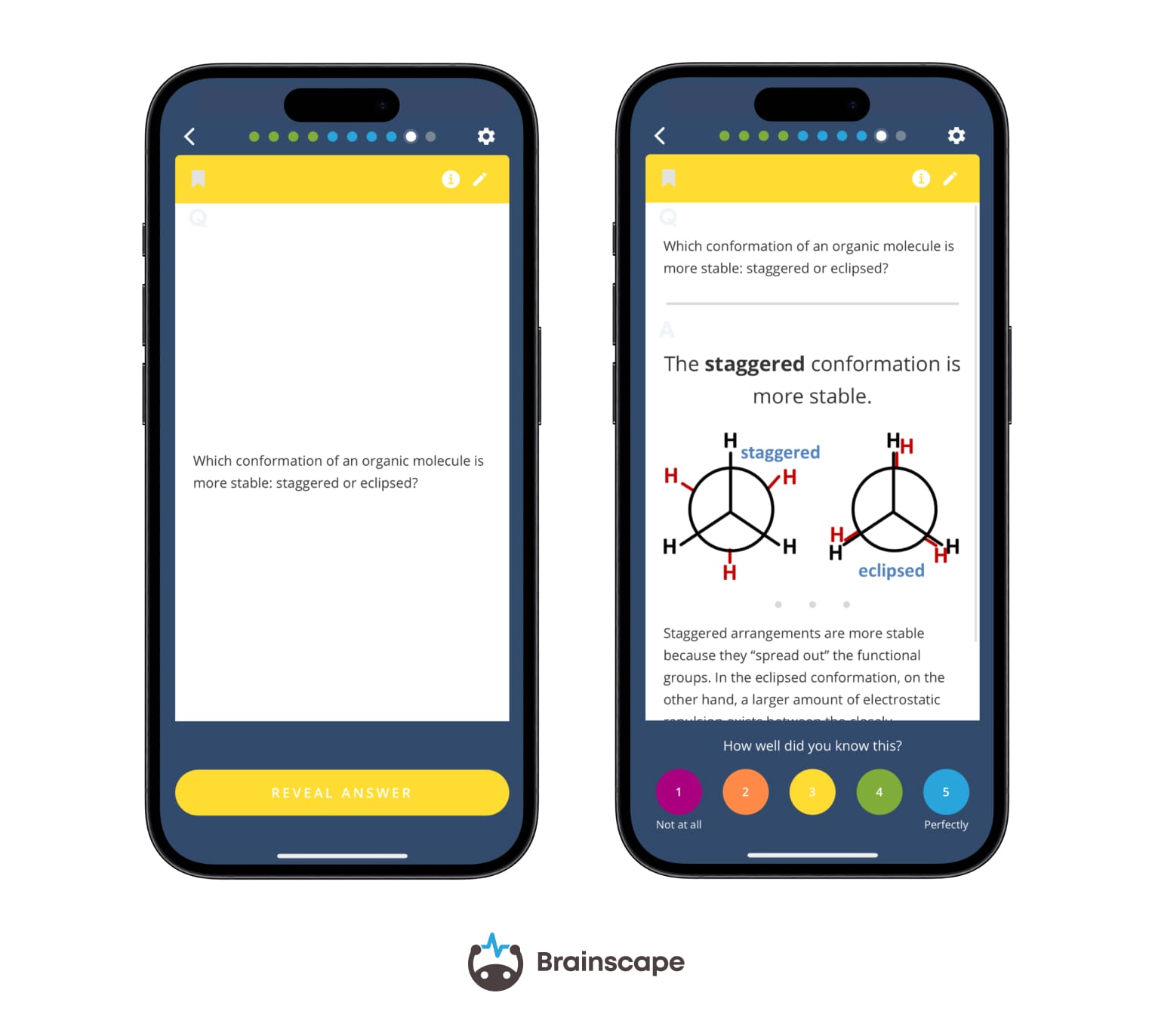Here’s a fun fact: approximately 44 million gallons of water go over Niagara Falls every minute of the day. What does this have to do with medical school? Well, being IN medical school is like standing at the base of the falls, trying to drink the deluge of water that relentlessly slams into your face; only that water is knowledge, and if you don’t retain it, you may not become a doctor!
Dramatic, yes. But there will be times it feels this way. The good news is you’ve tapped into one of the most efficient and effective ways to absorb enormous amounts of information in a short amount of time: FLASHCARDS! Specifically, Brainscape’s adaptive flashcards for medical students leverage key cognitive learning principles to help you retain all that medical content quickly and remember it for longer.
In this guide, we’ll show you how to get the very most out of Brainscape to make your days in medical school easier and exam study a breeze.
Use Brainscape To Make Your Own Flashcards
Many medical students who study with Brainscape initially discovered us through our certified USMLE Step 1 or MCAT flashcards. And while these expert-curated and vetted sets are the perfect study tool for these major milestone examinations, we really encourage you to use Brainscape to make your own flashcards during and throughout medical school.
A major part of the learning and memorization process is taking that overwhelming volume of information you’re covering in class (or reading about in your assignments) and distilling it into a collection of flashcards covering the most essential facts. Brainscape’s flashcard editing tools are specifically designed to help you do this quickly and easily, as is shown in the following animation:
- Create a class, e.g., “Anatomy & Physiology”
- Create flashcard decks for each topic covered in that class, e.g. Cardiology, oncology, endocrinology, etc. Consider this your class outline.
- Every day, after class, add flashcards to the relevant decks as you progress.
Make And Study Flashcards DAILY As You Progress Through Medical School
Crucial to success in medical school is spending a little time EVERY DAY on processing and consolidating what was covered in class that day. What does this look like?
- After class or at the end of each day, go through your lecture notes, assigned readings, and the textbook and make flashcards for the most important facts.
- Then, spend a little time studying your flashcards to really drill that content into your brain. Even just 20 to 30 minutes of daily review will put you far ahead of your peers and allow you to scaffold your knowledge methodically.
- PROTIP: This is much more convenient using the Brainscape mobile app
Remember, it’s KEY to keep up with this daily flashcard creation and studying so that when exams roll around, you’ll already have a deep understanding of the necessary content, whereas all your peers will likely have to go back to the material covered right at the beginning of the class and study it from scratch.
Pro Tip: Use those short periods of “downtime” between classes, on the treadmill, or during your daily commute to study your flashcards. Even just 5 minutes here and 10 minutes there add up. If you’re good about doing this, you could get your daily review done well before the end of the day, freeing up your evenings for other important things.
Collaborate On Making Flashcards With Your Classmates Or Study Group
You don’t have to make flashcards all on your own. In fact, we really recommend that you get your classmates or study group into Brainscape so that you can divide and conquer the task of flashcard creation. Every week, take the assigned textbook chapters/readings and allocate a portion of them to each member of your group.
By the end of the week, each person should have made flashcards in their shared Brainscape class, which you can then review as a group for accuracy and completeness. This not only saves you all time but also deepens the learning process as you discuss the cards, how they can be improved, and certain facts that may have been missed.
Here’s how to invite other students to become collaborators in a class you have created.
Source Already-Made Flashcards By Other Medical Students And Educators

Making your own flashcards and collaborating with classmates is integral to the learning process. However, if you fall behind and want to quickly catch up OR see what other top medical students have done (and use their flashcards to augment your own), head over to Brainscape’s Knowledge Genome for medicine!
Here, you’ll find a vast library of user-generated flashcards made by thousands of top medical students and educators. This user-generated content is ranked by an algorithm so that the most popular flashcards rise to the top of the list, giving you a decent measure of quality and comprehensiveness. You can use these decks verbatim, and/or you can cherry-pick content from them by copying and pasting (and editing) information to augment your own flashcard sets.
This allows you to mix and match your way to the perfect personal study stream that obsessively attacks YOUR weaknesses with the least amount of effort.
Use Brainscape’s Certified USMLE Step 1 Flashcards
In our Knowledge Genome, you’ll also discover our certified USMLE Step 1 flashcards, an expert-curated and vetted collection of 83 decks and 9,500+ flashcards. Now, although you will have made your own flashcards—maybe collaborating with your fellow students in the process—these flashcards are specifically tailored to meet the demands of the USMLE Step 1.

Our advice is to actually use these Brainscape-certified flashcards to study for your tests and exams throughout medical school, so that when the time comes to take the USMLE, your flashcards' confidence ratings will be prepared for super-efficient review. This will set you up to focus exclusively on your weaknesses—the concepts you haven’t quite managed to master yet—without wasting any time on the facts you already know (because you would already have perfected them throughout medical school).
So, in addition to your own flashcards, use Brainscape’s certified USMLE flashcards to study for your medical school exams.
Start A Little Side Hustle: Become A Campus Rep For Brainscape!
Medical school is expensive and a full-time job, so good luck trying to earn any money in your first few years! The good news is that Brainscape is always looking for campus reps to spread the word about our flashcards, and this side gig can earn you a little money!
Here’s how it works:
- Fill out our campus rep form,
- We’ll generate a custom discount code,
- Share that with your peers, and
- Earn a percentage royalty from anyone who upgrades to Brainscape Pro to access our full content and features.
If you’ve discovered the game-changing benefits of Brainscape, you’re in a unique position to help other medical students who might be struggling to cope with the overwhelming crush of content. Sharing Brainscape with them not only gives them the personal learning tool they need to do well but also earns you a little cash incentive. Nice!
Key Takeaways: Using Brainscape In Medical School
So there are several ways you can leverage Brainscape as a powerful study tool for medical school:
- Make your own flashcards for your various medical school classes;
- Use Brainscape to create and study flashcards daily so that you memorize the content as you progress, rather than cramming it all right before your exams;
- Collaborate with your classmates or study group on making flashcards to save time, deepen your learning, and make studying more fun;
- Find flashcards that have been made by other top medical students and educators on Brainscape’s Knowledge Genome and use these to augment your own sets;
- Use Brainscape’s certified USMLE Step 1 flashcards to crush this milestone exam;
- Become a campus rep for Brainscape, helping your fellow medical students learn more efficiently while earning a little money.
Used correctly and consistently, Brainscape is your ultimate study weapon to conquer medical school!
